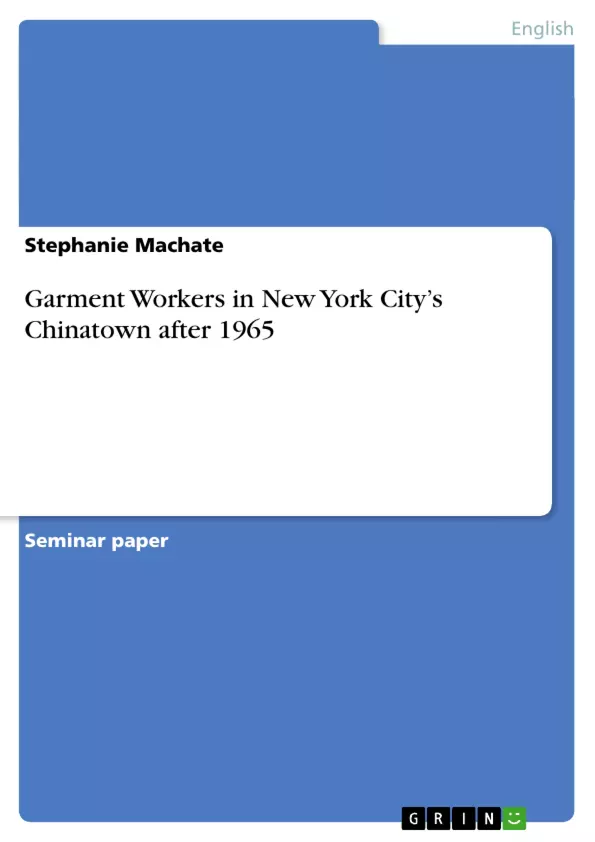In this research paper the focus shall be on Chinese workers in the garment factories of New York City’s Chinatown as an example of immigrant workers in the United States. After the Immigration Act of 1965, which abolished the national origin system and gave priority to the reunification of families, chain immigration in the United States of America started in large numbers. The most visible beneficiaries were the Asians because the quota system was abandoned for them. A lot of Chinese immigrants, especially women, entered the United States with this chain immigration. The high number of women amongst the immigrats was a reason that the former bachelor’s society – which means that the Chines male population outnumbered Chinese women in New York City on a large scale – turned into an almost well – balanced one. The labor force of the newly arrived women enabled the growth of New York City’s garment industry.
According to some statistics of Min Zhou and Regina Nordquist, the concentration of immigrant Chinese women in the garment industry was – and still is – extraordinary. Almost 85% of the work force in Chinatown’s garment industry are immigrant women, and the largest group of them are Chinese immigrant women (Zhou/ Nordquist 262). Because of the large-scale immigration after 1965 and the large supply of female work force, the garment industry of New York City’s Chinatown continued to be based on low-cost immigrant labor (Zhou/ Nordquist 261). Overall, more than half of Chinese women find jobs in garment factories. Because of the obvious dominance of Chinese immigrant women’s labor force in the garment industry, this research paper will concentrate on them.
Although these women earn only minimum or even lower wages, the labor force participation rate of them is exceptional high: 73% (Zhou/ Nordquist 264). Despite long wrking days and bad working conditions, it appears that Chinese garment workers do not feel exploited. In the following we will examine the situation of Chinese garment workers a little bit more in detail.
Inhaltsverzeichnis (Table of Contents)
- Introduction
- Conditions in Garment Factories
- Poor Conditions
- An Example: Xue Yan Huang
- Acceptance of low-wage work
- Women are Expected to Support their Families
- Lacking Opportunities
- Opportunities offered by the Garment Industry
- Reference Group for Chinese Immigrant Women
- Characteristics of Chinese Immigrant Women in the 1980s
Zielsetzung und Themenschwerpunkte (Objectives and Key Themes)
This research paper aims to examine the situation of Chinese immigrant workers in the garment factories of New York City's Chinatown after the Immigration Act of 1965. The paper explores the reasons behind the high concentration of Chinese women in this industry, the working conditions they face, and the factors that contribute to their acceptance of low-wage work.
- The impact of the Immigration Act of 1965 on Chinese immigration to the United States
- The role of Chinese immigrant women in the garment industry in New York City's Chinatown
- The working conditions and exploitation faced by Chinese garment workers
- The factors that contribute to the acceptance of low-wage work among Chinese immigrant women
- The social and economic implications of the garment industry's reliance on immigrant labor
Zusammenfassung der Kapitel (Chapter Summaries)
- Introduction: This chapter provides an overview of the research topic and sets the context for the study. It discusses the impact of the Immigration Act of 1965 on Chinese immigration and the subsequent growth of the garment industry in Chinatown.
- Conditions in Garment Factories: This chapter delves into the poor working conditions prevalent in Chinatown's garment factories, highlighting the exploitation of Chinese immigrant women. It discusses the lack of safety measures, long working hours, and low wages prevalent in these factories.
- An Example: Xue Yan Huang: This chapter presents a case study of a Chinese immigrant woman named Xue Yan Huang, illustrating the harsh realities of working in a Chinatown garment factory. It describes her experience of injury, her struggle for compensation, and the lack of support she received from the factory owners.
Schlüsselwörter (Keywords)
This research paper focuses on the key themes of Chinese immigration, garment industry, immigrant labor, working conditions, exploitation, low-wage work, and the acceptance of such work by Chinese immigrant women in New York City's Chinatown.
- Citar trabajo
- Stephanie Machate (Autor), 2005, Garment Workers in New York City’s Chinatown after 1965, Múnich, GRIN Verlag, https://www.grin.com/document/75833



